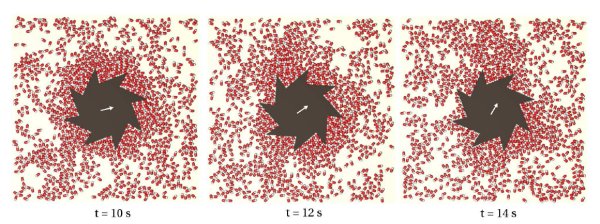
A group of physicists in Italy believes that mobile bacteria could convert chemical energy into mechanical energy by pushing on the teeth of tiny gear wheels. The researchers used computer simulations to show that, unlike the thermal motion of inanimate particles, the chaotic movements of bacteria could be used to continuously rotate asymmetrically-shaped gears. Such micromotors could potentially be used as energy sources, they claim.
Scientists are increasingly looking to biology in order to build tiny devices. In particular, they are attempting to propel micrometre-sized structures using preassembled motors found in unicellular organisms. Recently, Yuichi Hiratsuka of the University of Tokyo and colleagues built a rotor 20 μm in diameter and rotated it using bacteria attached to its surface.
Luca Angelani, Roberto Di Leonardo and Giancarlo Ruocco of the University of Rome La Sapienza and the National Research Council, however, believe that it is not necessary to actually bind bacteria to a rotor. Instead, they claim, a suitably-designed asymmetric gear wheel can be set in motion spontaneously when it is immersed in a bath containing bacteria.
Modelling motion
To demonstrate this, Angelani’s team modelled the interaction of a collection of E coli bacteria with a saw-tooth gear (arXiv:0812.2375 ). Each E coli bacterium, just 3 μm long, contains a set of rotary motors that drive long filaments extending behind the bacterium that allow it to swim. Angelani and colleagues modelled the motion of an idealized bacterium, assuming that its motion can be impeded by a combination of tumbling, which involves reversing the motors, and direct contact with neighbouring bacteria. They ignored two minor factors — Brownian motion and flow currents induced by the swimming neighbours.
We are like mankind before the industrial revolution…In the absence of efficient micro-engines we have to resort to living organisms as power sources Roberto Di Leonardo, University of Rome La Sapienza
The team then worked out the net direction of the force imparted by the bacteria on the saw-tooth gear 50 μm in diameter. This involved balancing the force imparted by all bacteria striking the long edge of each tooth, tending to rotate the gear in a clockwise direction, with the force due to those bacteria becoming lodged against the short edge of each tooth, causing an anticlockwise rotation. The researchers showed that the net effect is an overall anticlockwise motion of about two revolutions per minute, with fluctuations in this speed as the gear rotates.
Di Leonardo says that the same result would not be obtained with an asymmetric gear immersed in a reservoir of atoms or molecules held at thermal equilibrium. What makes the difference, he says, is the self-propelled motion of the bacteria, tending to push the gear wheel rather than simply bouncing off it. Another way of looking at this, he points out, is to consider entropy. The continuous conversion of chemical energy into mechanical energy by the bacteria leads to a continuous increase in entropy within the system, and it is this rise in entropy that permits the system to violate time-inversion symmetry, in other words to evolve in a particular direction, i.e. an anticlockwise rotation. “Bacterial motions are governed by irreversible dynamical equations and they can therefore set asymmetrically shaped objects into motion,” he adds.
Modelling motion
Di Leonardo hopes that the group’s work might “stimulate discussion about the fundamentals of statistical mechanics and its extension to the non-equilibrium world of living organisms”. He also believes the research could have technological applications, by showing how bacteria could be used for material transport, propulsion and mechanical operation at the micrometre scale. And he says that bacteria might even be used as a new kind of energy source, by feeding them and then converting the resultant mechanical output. “We are like mankind before the industrial revolution, but at the microscale,” he adds. “In the absence of efficient micro-engines we have to resort to living organisms as power sources.”
The group is now looking to convert its computer simulation into experimental reality, by producing saw tooth gears and other asymmetric objects with dimensions of just a few tens of micrometres. Howard Berg, a biophysicist at Harvard University in the US, believes it is important that the group do this as their simulation could be oversimplified. “Bacteria behave in rather complex ways near surfaces,” he says. “E colitends to swim parallel to the surface along spiral paths.”



